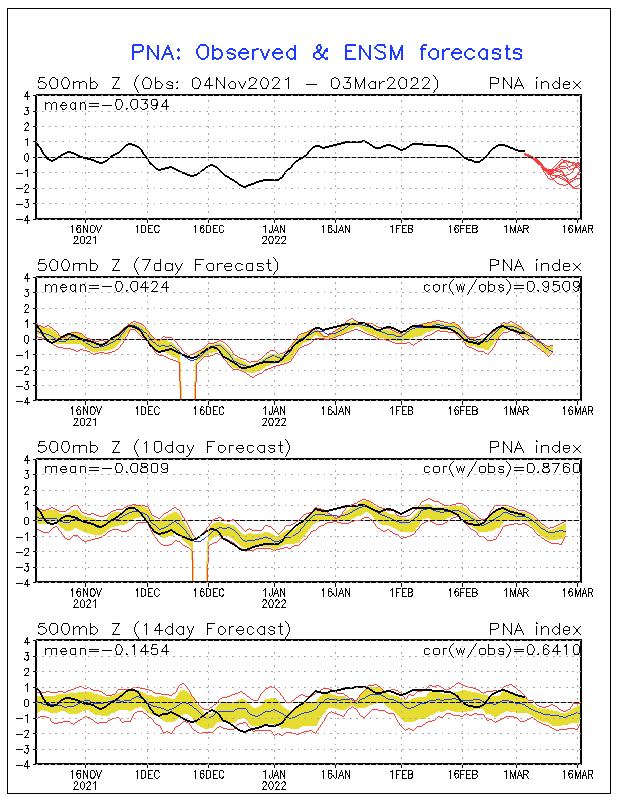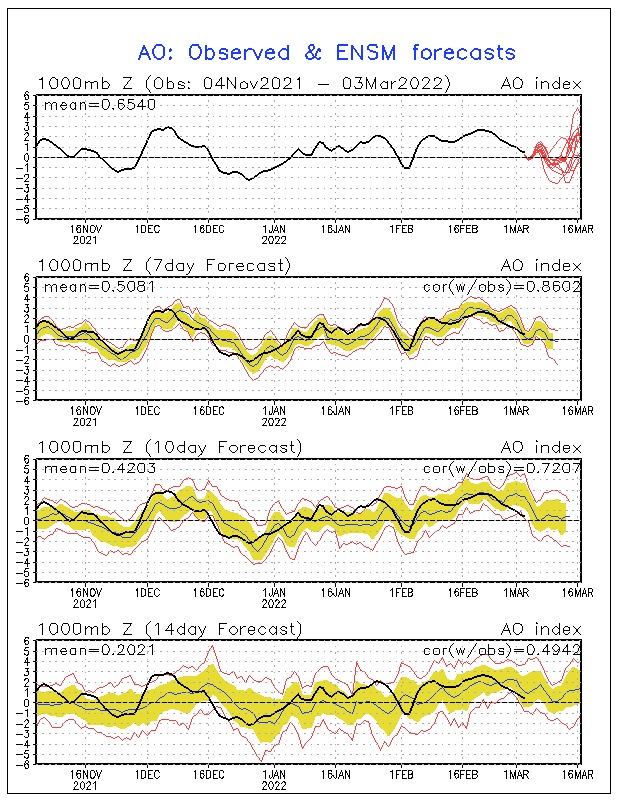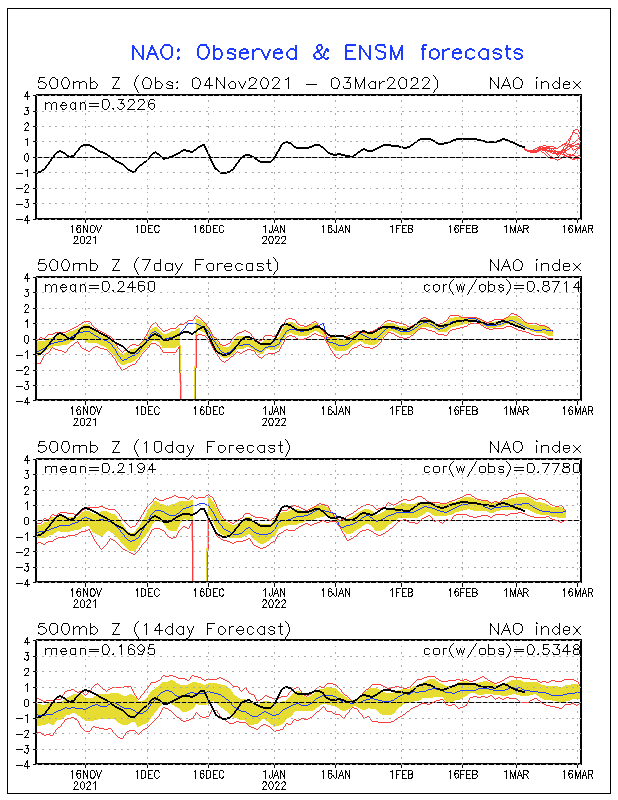North America View
http://web.wright-weather.com/wxp-model ... rt_h24.gif
http://web.wright-weather.com/wxp-model ... rt_h48.gif
http://web.wright-weather.com/wxp-model ... rt_h72.gif
http://web.wright-weather.com/wxp-model ... rt_h96.gif
Pacific View
http://web.wright-weather.com/wxp-model ... rt_h24.gif
http://web.wright-weather.com/wxp-model ... rt_h48.gif
http://web.wright-weather.com/wxp-model ... rt_h72.gif
http://web.wright-weather.com/wxp-model ... rt_h96.gif
At the same time, a strong low coming into the Pacific Northwest Thursday and Friday opens up and splits as once piece heads up into Canada, and the second digs into the four corners region and closes off. This also helps to increase the amplitude of the trough in the western part of the country, and therefore, amplifies the ridge downstream.
Because the NAO is positive, there is no 50/50 low, or cold high over the Great lakes, and the strong ridge over the eastern part of the country, the s/w across the four corners region lifts out into the central plains on Monday as the trough tilts negative instead of being forced to take a more suppressed track, making it a threat to the eastern part of the country.
http://web.wright-weather.com/wxp-model ... t_h120.gif
http://web.wright-weather.com/wxp-model ... 20_850.gif
http://web.wright-weather.com/wxp-model ... 20_sfc.gif
http://web.wright-weather.com/wxp-model ... 20_500.gif
So we do know that this week’s event will be a well inland runner, and an all rain event for much of the great lakes, Northeast, New England, and Northern Mid Atlantic. Then as the s/w runs into the building ridge it begins to dampen out (opening up and losing amplitude) as it moves over the Great Lakes on Tuesday. The surface low weakens also as it tracks from the southern plains to the northeastern Great Lakes region Monday into Tuesday.
So after a milder start to the week across the Northeast, the aforementioned system sweeps a cold front across the Great Lakes, Northern Mid Atlantic and New England, on Wednesday, lowering heights, and bringing in slightly colder air.
http://web.wright-weather.com/wxp-model ... t_h168.gif
http://web.wright-weather.com/wxp-model ... 68_850.gif
http://web.wright-weather.com/wxp-model ... 68_500.gif
http://web.wright-weather.com/wxp-model ... 68_sfc.gif
What’s quite interesting though is that, according to the ECMWF, the new s/w sliding down the west coast along the eastern side of the offshore ridge digs in, closes off and eventually separates it’s self (cuts off) from the main flow on Wednesday, which therefore means that it gets held back off the southwest coast of California until something comes along to push it out. This as the NAO remains positive, and the sub-tropical trough is located directly north of Hawaii.
http://web.wright-weather.com/wxp-model ... t_h168.gif
http://web.wright-weather.com/wxp-model ... 68_500.gif
Meanwhile in Europe, the trough is progressing out of Scandinavia, and heights are rising across the western part of the continent as the Azores high intensifies (associated with the Positive NAO). So, we lose not only the signal for the trough in the east perpetuated by a negative NAO (Since it’s positive) and the teleconnection between the trough in Scandinavia and the trough in the eastern part of the country.
Since we have the input from the Cahirs ridge to push cross-polar air onto our side of the pole, we would then want to try to see where the mean trough sets up in order to determine where that air would go. Many of the critical teleconnections (NAO, PNA, location of the sub-tropical trough in relationship to Hawaii, and Scandinavia Pattern) suggest that the trough is in the western part of North America, and the Southeast ridge is going away no time soon.
Here are the GFS ensemble representations of the trends in the AO, NAO, and PNA over the next 15 days.
PNA

AO

NAO

The GFS ensembles don’t appear to be in good agreement with the past few runs of the operational ECMWF, as they continue to show a mostly negative NAO over the remainder of the period (only slight trends toward positive). The ensembles also suggest a mostly negative AO (which is correct if the rex blocking scenario comes to fruition) and increasingly positive PNA, especially toward the end of the period.
If the trough is to come back into the east over the next 10 days, and the southeast ridge flatten against the ECMWF representation of the critical teleconnections, the energy that cuts off over the southwest around the middle of next week (providing that it’s not more progressive, since the ECMWF can at times have trouble with holding things like this back) the polar get would not be able to amplify into the west, and would instead be directed southeast over top of it, developing a weak trough in the eastern part of the country and flattening the southeast ridge. All the while, the polar vortex remains across north central Canada and western Baffin Island.
http://web.wright-weather.com/wxp-model ... t_h168.gif
By this time, the Cahirs connection will have done its job in sending a fairly strong cross polar air mass into far northern Canada, however with no real amplification of the pattern here in North America toward mid week; it stays up across northern Canada.
http://web.wright-weather.com/wxp-model ... 68_850.gif
By the end of the period (day 10) we notice the positive height anomaly along the north shore of Alaska earlier on breaks off and begins to track toward the North Pole, helping the vortex to stay put along the north shore of Hudson Bay. The trough is centered across the northern Midwest, but the southeast ridge which earlier on was quite amplified is now more of a flat ridge, and heights are nowhere near as high across the northeast as what they were earlier on in the week. Later on, as the SOI turns negative, the sub-tropical trough near or west of Hawaii should get pushed back to the east of Hawaii, and the energy held back (if it’s held back) across the southwest comes out, making things interesting after the 5th. Especially since we have all the cross polar air up in Canada that can get involved given amplification, possibly having a big impact after March 7th.
http://web.wright-weather.com/wxp-model ... 40_500.gif
http://web.wright-weather.com/wxp-model ... 40_500.gif
http://web.wright-weather.com/wxp-model ... 40_500.gif
Overall to summarize the theme of the next 10 days is the trough is in the western part of the country, the early week system weakens as it lifts toward the Great Lakes and encounters the building ridge in the east, and ends the milder pattern by Wednesday and Thursday as a moderate cold front pushes through the region. After that it’s back to normal or slightly below normal temperatures. But no major snow events for anyone, following this week’s event in the Carolinas, and southeast.
If a major March Nor’easter/winter storm is to occur it would probably do so between the 10th and 20th of the month. Post later tomorrow night on that, if I have some extra time.
 The posts in this forum are NOT official forecast and should not be used as such. They are just the opinion of the poster and may or may not be backed by sound meteorological data. They are NOT endorsed by any professional institution or
The posts in this forum are NOT official forecast and should not be used as such. They are just the opinion of the poster and may or may not be backed by sound meteorological data. They are NOT endorsed by any professional institution or 








